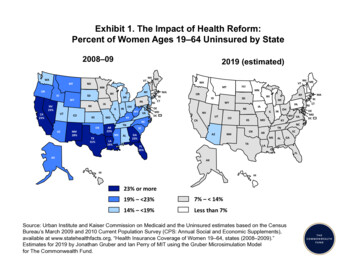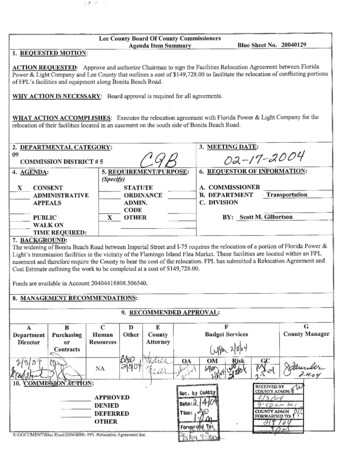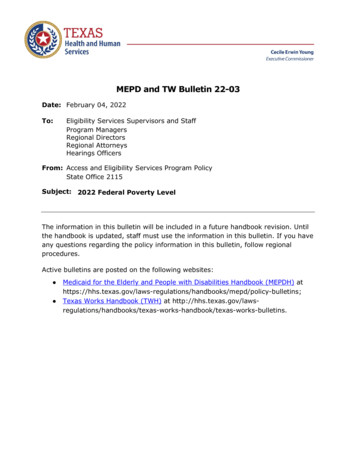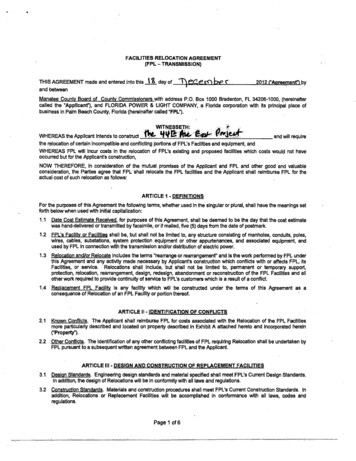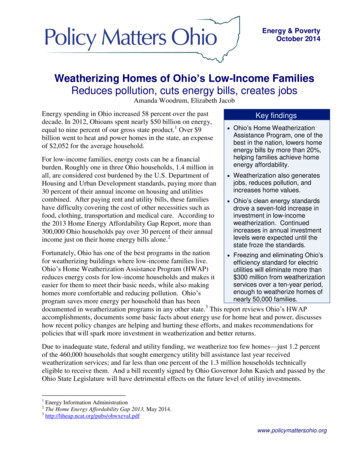
Transcription
EXHIBIT 8FPL GROUP ANNUAL REPORTS AND FORMS 10-KFOR YEARS ENDED 2000 AND 2001
UNITED STATES SECURITIES AND EXCHANGE COMMISSIONWASHINGTON, D.C. 20549FORM 10-K/A[X] ANNUAL REPORT PURSUANT TO SECTION 13 OR 15(d) OF THE SECURITIES EXCHANGE ACT OF 1934For the fiscal year endedDecember 31, 2000ORTRANSITION REPORT PURSUANT TO SECTION 13 OR 15(d) OF THE SECURITIES EXCHANGE ACT OF 1934CommissionFile Number1-88411-3545Exact name of Registrants as specified in their charters, address ofprincipal executive offices and Registrants' telephone numberIRS EmployerIdentification NumberFPL GROUP, INC.FLORIDA POWER & LIGHT COMPANY59-244941959-0247775700 Universe BoulevardJuno Beach, Florida 33408(561) 694-4000State or other jurisdiction of incorporation or organization: FloridaName of exchangeon which registeredSecurities registered pursuant to Section 12(b) of the Act:FPL Group, Inc.: Common Stock, 0.01 Par Value and Preferred Share Purchase RightsFlorida Power & Light Company: NoneNew York Stock ExchangeSecurities registered pursuant to Section 12(g) of the Act:FPL Group, Inc.: NoneFlorida Power & Light Company: Preferred Stock, 100 Par ValueIndicate by check mark whether the registrants (1) have filed all reports required to be filed by Section 13 or 15(d) of the Securities Exchange Act of 1934 during theNopreceding 12 months and (2) have been subject to such filing requirements for the past 90 days. Yes XIndicate by check mark if disclosure of delinquent filers pursuant to Item 405 of Regulation S-K is not contained herein, and will not be contained, to the best ofRegistrants' knowledge in definitive proxy or information statements incorporated by reference in Part IIIof this Form 10-K or any amendment to this Form 10-K. [ ]Aggregate market value of the voting stock of FPL Group, Inc. held by non-affiliates as of January31, 2001 (based on the closing market price on the CompositeTape on January 31, 2001) was 10,180,979,540 (determined by subtracting from the number of shares outstanding on that date the number of shares held bydirectors and officers of FPL Group, Inc.).There was no voting stock of Florida Power & Light Company held by non-affiliates as of January 31, 2001.The number of shares outstanding of each class of FPL Group, Inc. common stock, as of the latest practicable date: Common Stock, 0.01 Par Value, outstandingat January 31, 2001: 175,819,435 sharesAs of January 31, 2001, there were issued and outstanding 1,000 shares of Florida Power & Light Company's common stock, without par value, all of which wereheld, beneficially and of record, by FPL Group, Inc.DOCUMENTS INCORPORATED BY REFERENCEPortions of FPL Group, Inc.'s Proxy Statement for the 2001 Annual Meeting of Shareholders are incorporated by reference in Part IlIIhereof.This combined Form 10-K/A represents separate filings by FPL Group, Inc. and Florida Power & Light Company. Informationcontained herein relating to an individual registrant is filed by that registrant on its own behalf. Florida Power & LightCompany makes no representations as to the information relating to FPL Group, Inc.'s other operations.
DEFINITIONSAcronyms and defined terms used in the text include the following:Ter Meaningcapacity clauseCapacity cost recovery clauseCentral Maine Power CompanyRestated Articles of Incorporation, as amended, of FPL Group or FPL, asthe case may beThe Coalition for Equitable RatesEnergy conservation cost recovery clauseU.S. Department of EnergyElectric and magnetic fieldsEnergy Marketing & TradingEntergy CorporationEnvironmental compliance cost recovery clauseFinancial Accounting standards No.Florida Department of Environmental ProtectionFederal Energy Regulatory commissionThe Florida Industrial Power Users GroupFlorida Gas Transmission CompanyFlorida Municipal Power AgencyFlorida Power & Light CompanyFPL Energy, LLCFPL FiberNet, LLCFPL Group, Inc.FPL Group Capital IncFlorida Public service CommissionFuel and purchased power cost recovery clauseGridFlorida LLCPublic utility Holding Company Act of 1935, as amendedInternational Brotherhood of Electrical WorkersJacksonville Electric AuthorityKilovoltKilowatt-hourItem 7. Management's Discussion and Analysis of Financial Conditionand Results of OperationsFPL's Mortgage and Deed of Trust dated as of January 1, 1944, assupplemented and amendedCMPcharterCoalitionconservation RCFIPUGFGTFMPAFPLFPL EnergyFPL FiberNetFPL GroupFPL Group CapitalFPSCfuel clauseGridFloridaHolding Company ActIBEWJEAkvkwhManagement's DiscussionmortgagemwMegawatt(s)NoteNRCNuclear Waste Policy ActNoteto Consolidated Financial StatementsU.S. Nuclear Regulatory CommissionNuclear Waste Policy Act of 1982other operations and maintenance expenses in the consolidatedstatements of IncomeFPL Energy Power Marketing, Inc.State of Florida office of Public counselPublic utility Regulatory Policies Act of 1978, as amendedNon-utility power production facilities meeting the requirements of aqualifying facility under the PURPAPrivate Securities Litigation Reform Act of 1995Return on common equityRegional transmission organizationsSt. Johns River Power ParkO&M expensesPMIPublic CounselPURPAqualifying facilitiesReform ActROERTOsSJRPP2
SAFE HARBOR STATEMENT UNDER THE PRIVATE SECURITIES LITIGATION REFORM ACT OF 1995In connection with the safe harbor provisions of the Reform Act, FPL Group and FPL (collectively, the Company) are herebyfiling cautionary statements identifying important factors that could cause the Company's actual results to differ materiallyfrom those projected in forward-looking statements (as such term is defined in the Reform Act) made by or on behalf of theCompany which are made in this combined Form 10-K/A, in presentations, in response to questions or otherwise. Anystatements that express, or involve discussions as to expectations, beliefs, plans, objectives, assumptions or future events orperformance (often, but not always, through the use of words or phrases such as will likely result, are expected to, willcontinue, is anticipated, estimated, projection, outlook) are not statements of historical facts and may be forward-looking.Forward-looking statements involve estimates, assumptions and uncertainties. Accordingly, any such statements arequalified in their entirety by reference to, and are accompanied by, the following important factors that could cause theCompany's actual results to differ materially from those contained in forward-looking statements made by or on behalf of theCompany.Any forward-looking statement speaks only as of the date on which such statement is made, and the Company undertakes noobligation to update any forward-looking statement to reflect events or circumstances after the date on which such statementis made or to reflect the occurrence of unanticipated events. New factors emerge from time to time and it is not possible formanagement to predict all of such factors, nor can it assess the impact of each such factor on the business or the extent towhich any factor, or combination of factors, may cause actual results to differ materially from those contained in any forwardlooking statement.Some important factors that could cause actual results or outcomes to differ materially from those discussed in the forwardlooking statements include changes in laws or regulations, changing governmental policies and regulatory actions, includingthose of the FERC, the FPSC, the PURPA, the Holding Company Act and the NRC, with respect to allowed rates of returnincluding but not limited to ROE and equity ratio limits, industry and rate structure, operation of nuclear power facilities,acquisition, disposal, depreciation and amortization of assets and facilities, operation and construction of plant facilities,recovery of fuel and purchased power costs, decommissioning costs, and present or prospective wholesale and retailcompetition (including but not limited to retail wheeling and transmission costs).The business and profitability of the Company are also influenced by economic and geographic factors including political andeconomic risks, changes in and compliance with environmental and safety laws and policies, weather conditions (includingnatural disasters such as hurricanes), population growth rates and demographic patterns, competition for retail and wholesalecustomers, availability, pricing and transportation of fuel and other energy commodities, market demand for energy fromplants or facilities, changes in tax rates or policies or in rates of inflation or in accounting standards, unanticipated delays orchanges in costs for capital projects, unanticipated changes in operating expenses and capital expenditures, capital marketconditions, competition for new energy development opportunities and legal and administrative proceedings (whether civil,such as environmental, or criminal) and settlements.All such factors are difficult to predict, contain uncertainties which may materially affect actual results, and are beyond thecontrol of the Company.3
PART IItem 1. BusinessFPL GROUPFPL Group is a public utility holding company, as defined in the Holding Company Act. It was incorporated in 1984 under thelaws of Florida. FPL Group's principal subsidiary, FPL, is engaged in the generation, transmission, distribution and sale ofelectric energy. FPL Group Capital, a wholly-owned subsidiary of FPL Group, holds the capital stock and provides funding forthe operating subsidiaries other than FPL. The business activities of these operating subsidiaries primarily consist of FPLEnergy's independent power projects. For financial information regarding segments, see Note 14. At December 31, 2000,FPL Group and its subsidiaries employed 10,852 persons.FPL Group is exempt from substantially all of the provisions of the Holding Company Act on the basis that FPL Group's andFPL's businesses are predominantly intrastate in character and carried on substantially in a single state in which both areincorporated.In July 2000, FPL Group and Entergy announced a proposed merger, which was approved by the shareholders of therespective companies in December 2000. Subsequently, a number of factors led FPL Group to conclude the merger wouldnot achieve the synergies or create the shareholder value originally contemplated when the merger was announced. As aresult, on April 1, 2001, FPL Group and Entergy mutually terminated the merger agreement. For additional informationconcerning the merger, see Note 2.FPL OPERATIONSGeneral. FPL was incorporated under the laws of Florida in 1925 and is a wholly-owned subsidiary of FPL Group. FPLsupplies electric service throughout most of the east and lower west coasts of Florida with a population of more than sevenmillion. During 2000, FPL served approximately 3.8 million customer accounts. Operating revenues were as follows:Years Ended December 31,200019991998(millions)Residential .Commercial .Industrial .other, including the provision forretail rate refund and the netchange in unbilled revenues . 3,5042,299181 3,3572,226190 3,5802,239197377284350Regulation. The retail operations of FPL provided approximately 99% of FPL's operating revenues for 2000. Suchoperations are regulated by the FPSC which has jurisdiction over retail rates, service territory, issuances of securities,planning, siting and construction of facilities and other matters. FPL is also subject to regulation by the FERC in variousrespects, including the acquisition and disposition of facilities, interchange and transmission services and wholesalepurchases and sales of electric energy.FPL's nuclear power plants are subject to the jurisdiction of the NRC. NRC regulations govern the granting of licenses for theconstruction and operation of nuclear power plants and subject such power plants to continuing review and regulation.Federal, state and local environmental laws and regulations cover air and water quality, land use, power plant andtransmission line siting, EMF from power lines and substations, noise and aesthetics, solid waste and other environmentalmatters. Compliance with these laws and regulations increases the cost of electric service by requiring, among other things,changes in the design and operation of existing facilities and changes or delays in the location, design, construction andoperation of new facilities. See Item 3. Legal Proceedings. Capital expenditures required to comply with environmental lawsand regulations for 2001-03 are included in FPL's projected capital expenditures set forth in Item 1. Business - FPLOperations - Capital Expenditures and are not material.FPL currently holds 172 franchise agreements with varying expiration dates to provide electric service in variousmunicipalities and counties in Florida. FPL considers its franchises to be adequate for the conduct of its business.Retail Ratemaking. The underlying concept of utility ratemaking is to set rates at a level that allows the utility the opportunityto collect from customers total revenues (revenue requirements) equal to its cost of providing service, including a reasonablerate of return on invested capital. To accomplish this, the FPSC uses various ratemaking mechanisms.The basic costs of providing electric service, other than fuel and certain other costs, are recovered through base rates, whichare designed to recover the costs of constructing, operating and maintaining the utility system. These basic costs includeO&M expenses, depreciation and taxes, as well as a return on FPL's investment in assets used and useful in providingelectric service (rate base). The rate of return on rate base approximates FPL's weighted cost of capital, which includes its4
costs for debt and preferred stock and an allowed ROE. The FPSC monitors FPL's ROE through a surveillance report that isfiled monthly by FPL with the FPSC. The FPSC does not provide assurance that the allowed ROE will be achieved. Baserates are determined in rate proceedings which occur at irregular intervals at the initiative of FPL, the FPSC, Public Counselor a substantially affected party.FPL's last full rate proceeding was in 1984. In 1999, the FPSC approved a three-year agreement among FPL, Public Counsel,FIPUG and Coalition regarding FPL's retail base rates, authorized regulatory ROE, capital structure and other matters. Theagreement, which became effective April 15, 1999, provides for a 350 million reduction in annual revenues from retail baseoperations allocated to all customers on a cents-per-kilowatt-hour basis. Additionally, the agreement sets forth a revenue sharingmechanism for each of the twelve month periods covered by the agreement, whereby revenues from retail base operations inexcess of a stated threshold are required to be shared on the basis of two-thirds refunded to retail customers and one-thirdretained by FPL. Revenues from retail base operations in excess of a second threshold are required to be refunded 100% toretail customers.The refund thresholds are as follows:Twelve Months Ended200066 2/3% to customers .100% to customers . 3,400 3,556April 14.20012002 3,450 3,606 3,500 3,656(millions)The agreement allows for special depreciation of up to 100 million, at FPL's discretion, in each year of the three-year agreementperiod to be applied to nuclear and/or fossil generating assets. This new depreciation program replaced a revenue-based specialamortization program. See Note 1 - Revenue and Rates and Electric Plant, Depreciation and Amortization.The agreement also lowered FPL's authorized regulatory ROE range to 10% - 12%. During the term of the agreement, theachieved ROE may from time to time be outside the authorized range, and the revenue sharing mechanism described above isspecified to be the appropriate and exclusive mechanism to address that circumstance. For purposes of calculating ROE, theagreement establishes a cap on FPL's adjusted equity ratio of 55.83%. The adjusted equity ratio reflects a discounted amountfor off-balance sheet obligations under certain long-term purchased power contracts. Finally, included in the agreement areprovisions which limit depreciation rates and accruals for nuclear decommissioning and fossil dismantlement costs to currentlyapproved levels and limit amounts recoverable under the environmental clause during the term of the agreement.The agreement states that Public Counsel, FIPUG and Coalition will neither seek nor support any additional base ratereductions during the three-year term of the agreement unless such reduction is initiated by FPL. Further, FPL agreed to notpetition for any base rate increases that would take effect during the term of the agreement.Fuel costs are recovered through levelized charges per kwh established pursuant to the fuel clause and totaled 2.0 billion in2000. These charges are calculated annually based on estimated fuel costs and estimated customer usage for the followingyear, plus or minus a true-up adjustment to reflect the variance of actual costs and usage from the estimates used in settingthe fuel adjustment charges for prior periods. An adjustment to the levelized charges may be approved during the course of ayear to reflect a projected variance based on actual costs and usage. Due to higher than projected oil and natural gas pricesin 2000, the FPSC approved higher per kwh charges effective June 15, 2000. Later in the year, the FPSC approved FPL'sannual fuel filing for 2001, which included an estimate of under-recovered fuel costs in 2000 of 518 million. FPL will recoverthe 518 million over a two-year period beginning January 2001, rather than the typical one-year time frame. FPL has alsoagreed that instead of receiving a return at the commercial paper rate on this unrecovered portion through the fuel clause, theunder-recovery will be included as a rate base regulatory asset over the two-year recovery period. Actual under-recoveredfuel costs through December 31, 2000 exceeded the estimates made earlier in the year by 78 million, and in February 2001,FPL requested the FPSC to approve a fuel adjustment increase effective April 2001 to recover the additional 78 million ofunder-recovered fuel costs. See Note 1 - Regulation.Capacity payments to other utilities and generating companies for purchased power are recovered through the capacityclause and base rates. In 2000, 455 million was recovered through the capacity clause. Costs associated withimplementing energy conservation programs totaled 80 million in 2000 and are recovered through the conservation clause.Costs of complying with federal, state and local environmental regulations enacted after April 1993 totaled 12 million in 2000and are recovered through the environmental clause to the extent not included in base rates. The new rate agreement limitsrecovery under this clause to 12.8 million in 2000 and 6.4 million in 2001, with no further amounts recoverable during theremaining term of the agreement.The FPSC has the authority to disallow recovery of costs that it considers excessive or imprudently incurred. Such costs mayinclude O&M expenses, the cost of replacing power lost when fossil and nuclear units are unavailable and costs associatedwith the construction or acquisition of new facilities.5
Competition. The electric utility industry is facing increasing competitive pressure. FPL currently faces competition fromother suppliers of electrical energy to wholesale customers and from alternative energy sources and self-generation for othercustomer groups, primarily industrial customers. In 2000, operating revenues from wholesale and industrial customerscombined represented approximately 4% of FPL's total operating revenues. A number of potential merchant plants havebeen announced in Florida over the past several years. Five of these announced merchant plants totaling 3,700 mw havepresented submissions to seek a determination of need to the FPSC. In March 1999, the FPSC approved one of the petitionsfor a power plant to be constructed within FPL's service territory. FPL, along with other Florida utilities, appealed the decisionto the Florida Supreme Court. In April 2000, the Florida Supreme Court upheld arguments by FPL and other Florida utilities andruled that under current Florida law the FPSC is not authorized to grant a determination of need for a proposed power plant, theoutput of which is not fully committed to use by Florida retail customers. In March 2001, the United States Supreme Courtdenied a petition for certiorari review by one of the petitioners.Over half of the states, other than Florida, have enacted legislation or have state commissions that issued orders designed toderegulate the production and sale of electricity. By allowing customers to choose their electricity supplier, deregulation isexpected to result in a shift from cost-based rates to market-based rates for energy production and other services provided toretail customers. Similar initiatives are also being pursued on the federal level. Although the legislation and initiatives varysubstantially, common areas of focus include when market-based pricing will be available for wholesale and retail customers,what existing prudently incurred costs in excess of the market-based price will be recoverable and whether generation assetsshould be separated from transmission, distribution and other assets. It is generally believed transmission and distributionactivities would remain regulated.In 2000, the Governor of Florida signed an executive order creating the Energy 2020 Study Commission to propose anenergy plan and strategy for Florida. The order required that recommendations be made to the legislature and Governor byDecember 1, 2001. The commission chose to split the energy study between wholesale and retail competition. In January2001, the commission issued an interim report containing a proposal for restructuring Florida's wholesale market forelectricity. The proposal recommends the removal of statutory barriers to entry for merchant plants and, according to thereport, provides a transition to a "level playing field" for all generating assets. Under the commission's proposal, investorowned utilities such as FPL would establish, and transfer their generating assets to, affiliated exempt wholesale generators,which would also construct and operate new generating assets. The investor-owned load-serving utilities, such as FPL,would acquire energy resources through competitive bidding, negotiated contracts or from the short-term (spot) market.Purchases from affiliated exempt wholesale generators would be pursuant to a competitive bidding process. The proposalincludes a number of features, including a three-year retail base rate freeze. The proposal may be addressed in the nextlegislative session which takes place in March through May 2001. In addition, the FERC has jurisdiction over potentialchanges which could affect competition in wholesale transactions. The commission will now consider recommendations forthe retail market.In 1999, the FERC issued its final order on RTOs. RTOs, under a variety of structures, provide for the independent operationof transmission systems for a given geographic area. The final order establishes guidelines for public utilities to use inconsidering and/or developing plans to initiate operations of RTOs by December 15, 2001. In October 2000, FPL, togetherwith Florida Power Corporation and Tampa Electric Company, filed a joint proposal to form a fully independent for-profittransmission company that would be responsible for the transmission lines that carry electricity from power plants primarilywithin the state to substations in Florida. The October filing was supplemented by a December 2000 filing that providedcertain operational details of the proposed RTO.Under the proposed form of RTO, FPL would contribute its transmission assets to an independent transmission company,GridFlorida, that would own and operate the system. A separate corporation would be formed to own the voting interest inand manage GridFlorida. In return for its transmission assets, FPL would receive a non-voting ownership interest inGridFlorida, which could be exchanged for non-voting stock of the managing corporation. FPL would account for its interestin GridFlorida using the equity method.In the event the basis of regulation for some or all of FPL's business changes from cost-based regulation, existing regulatoryassets and liabilities would be written off unless regulators specify an alternative means of recovery or refund. Further, otheraspects of the business, such as generation assets and long-term power purchase commitments, would need to be reviewedto assess their recoverability in a changed regulatory environment. See Management's Discussion - Results of Operationsand Note 1 - Regulation.System Capability and Load. FPL's resources for serving summer load as of December 31, 2000 consisted of 19,069 mw,of which 16,864 mw are from FPL-owned facilities (see Item 2. Properties - Generating Facilities) and 2,205 mw are obtainedthrough purchased power contracts. See Note 13 - Contracts. FPL's reserve margin target is currently 15%. However, withthe FPSC's approval, FPL and two other Florida utilities voluntarily adopted a 20% reserve margin target to be achieved bythe summer of 2004.The compounded annual growth rate of retail kwh sales and number of retail customers was 3.4% and 2.1%, respectively, forthe three years ended December 31, 2000. It is anticipated that retail kwh sales will grow at a compounded annual rate ofapproximately 3.7% for the next three years.6
Occasionally, unusually cold temperatures during the winter months result in significant increases in electricity usage for shortperiods of time. However, customer usage and operating revenues are typically higher during the summer months largelydue to the prevalent use of air conditioning in FPL's service territory. On January 5, 2001, FPL set an all-time record forenergy peak demand of 18,219 mw. Adequate resources were available at the time of the peak to meet customer demand.FPL has begun construction to repower its two existing Fort Myers steam units and two of its three existing steam units at theSanford site. The repowering work at these sites is scheduled to be completed by the end of 2002. FPL will also add twonew gas-fired combustion turbines at each of its Martin site in 2001 and its Fort Myers site in 2003, and add new combustionturbines and/or gas-fired combined cycle units from 2005-10. These actions, plus other changes to FPL's existing units andpurchased power contracts, are expected to increase FPL's net generating capability by approximately 7,000 mw.Capital Expenditures. FPL's capital expenditures totaled approximately 1.3 billion in 2000, 924 million in 1999 and 617million in 1998. Capital expenditures for the 2001-03 period are expected to be 3.3 billion, including 1.1 billion in 2001.This estimate is subject to continuing review and adjustment, and actual capital expenditures may vary from this estimate.See Management's Discussion - Liquidity and Capital Resources.Nuclear Operations. FPL owns and operates four nuclear units, two at Turkey Point and two at St. Lucie. The operatinglicenses for Turkey Point Units Nos. 3 and 4 expire in 2012 and 2013, respectively. The operating licenses for St. Lucie UnitsNos. 1 and 2 expire in 2016 and 2023, respectively. FPL has informed the NRC of its intent to apply for a 20-year licenserenewal for each of its four nuclear units. FPL filed the license extension application with the NRC for the Turkey Point unitsin 2000 and expects to file in 2002 for the St. Lucie units. The nuclear units are periodically removed from service toaccommodate normal refueling and maintenance outages, repairs and certain other modifications. A condition of theoperating license for each unit requires an approved plan for decontamination and decommissioning. FPL's current plansprovide for prompt dismantlement of the Turkey Point Units Nos. 3 and 4 with decommissioning activities commencing in2012 and 2013, respectively. Current plans call for St. Lucie Unit No. 1 to be mothballed beginning in 2016 withdecommissioning activities to be integrated with the prompt dismantlement of St. Lucie Unit No. 2 beginning in 2023. Seeestimated cost data in Note 1 - Decommissioning and Dismantlement of Generating Plant.Fuel. FPL's generating plants use a variety of fuels. See Item 2. Properties - Generating Facilities and Note 13 - Contracts.The diverse fuel options, along with purchased power, enable FPL to shift between sources of generation to achieve aneconomical fuel mix.FPL has four firm transportation contracts in place with FGT that together will satisfy substantially all of the anticipated needsfor natural gas transportation. The four existing contracts expire in 2005, 2015, 2021 and 2022, respectively, but each can beextended at FPL's option. To the extent desirable, FPL can also purchase interruptible gas transportation service from FGTbased on pipeline availability. FPL has a long-term natural gas supply contract at market rates to provide a portion of FPL'santicipated needs for natural gas. The remainder of FPL's gas requirements are purchased under other contracts and in thespot market.FPL has, through its joint ownership interest in SJRPP Units Nos. 1 and 2, long-term coal supply and transportation contractsfor a portion of the fuel needs for those units. All of the transportation requirements and a portion of the fuel supply needs forScherer Unit No. 4 are covered by a series of annual and long-term contracts. The remaining fuel requirements will beobtained in the spot market. FPL's oil requirements are obtained under short- and long-term contracts and in the spot market.FPL leases nuclear fuel for all four of its nuclear un
General. FPL was incorporated under the laws of Florida in 1925 and is a wholly-owned subsidiary of FPL Group. FPL supplies electric service throughout most of the east and lower west coasts of Florida with a population of more than seven million. During 2000, FPL served approximately 3.8 million customer accounts.
